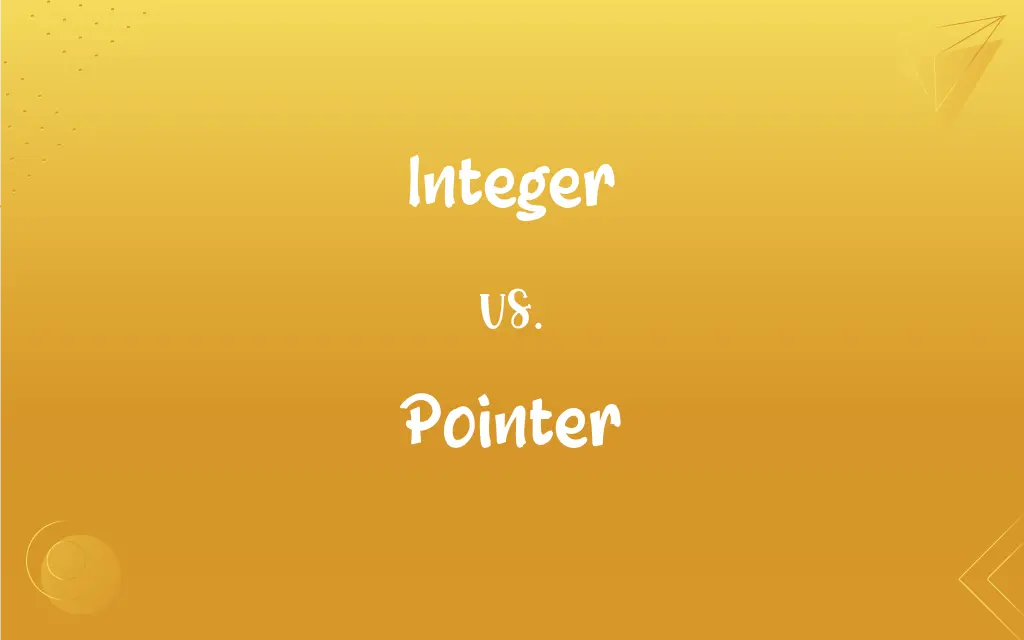Integer vs. Pointer: What's the Difference?
Edited by Aimie Carlson || By Janet White || Published on January 7, 2024
An integer is a whole number without fractions, while a pointer is a variable that stores the memory address of another variable.

Key Differences
An integer in programming represents a whole number, which can be either positive, negative, or zero. On the other hand, a pointer is a variable that holds the memory address of another variable, essentially pointing to its location in memory.
Integers are fundamental data types used to store numeric values in programming. Pointers, in contrast, are more complex and are used to reference the location of other variables, enabling dynamic memory management.
Arithmetic operations can be directly performed on integers, such as addition, subtraction, multiplication, and division. Whereas with pointers, arithmetic operations involve manipulating memory addresses, often used in array indexing and dynamic data structures.
In memory, an integer occupies space based on its data type (like int or long in C/C++), holding a specific numerical value. A pointer, however, occupies a consistent amount of space regardless of what it is pointing to, storing a memory address.
Type safety is strictly enforced with integers; operations are limited to numerical manipulations. Pointers require careful handling due to their ability to directly manipulate memory, which can lead to vulnerabilities like buffer overflows or memory leaks if mishandled.
ADVERTISEMENT
Comparison Chart
Definition
A whole number without fractions
A variable storing the memory address of another variable
Primary Use
To hold numeric values
To reference and manipulate variable locations in memory
Operations
Arithmetic (add, subtract, etc.)
Memory address manipulation, dynamic memory allocation
Memory Representation
Size depends on type (e.g., int, long)
Consistent size, stores an address
Safety and Complexity
Simple and type-safe
Complex with potential for memory-related errors
ADVERTISEMENT
Integer and Pointer Definitions
Integer
A whole number, positive or negative, without any fractional or decimal part.
The array index is an integer starting from zero.
Pointer
A tool for dynamic memory allocation and management.
The pointer was used to allocate memory dynamically for an array.
Integer
A numerical value used in mathematical operations.
The sum of two integers is always an integer.
Pointer
A means to implement complex data structures like linked lists.
Each node in the linked list contains a data value and a pointer.
Integer
An essential component in algorithms for counting or indexing.
Loop iterations are controlled using an integer variable.
Pointer
A concept used for referencing and dereferencing to access variable values.
Dereferencing a pointer accesses the value of the variable it points to.
Integer
In programming, a data type representing non-fractional numbers.
The integer variable 'count' stores the number of items.
Pointer
A variable that holds the memory address of another variable.
The pointer 'ptr' points to the memory address of 'num'.
Integer
A discrete value, as opposed to continuous values like floats.
Integer division yields an integer result without a remainder.
Pointer
In C/C++, a data type that references the location of data in memory.
A char pointer can store the address of a character array.
Integer
A member of the set of positive whole numbers {1, 2, 3, ... }, negative whole numbers {-1, -2, -3, ... }, and zero {0}.
Pointer
A long tapered stick or a laser beacon used to call attention to objects, as on a chart or blackboard.
Integer
A complete unit or entity.
Pointer
A scale indicator on a watch, balance, or other measuring instrument.
Integer
(arithmetic) A number that is not a fraction; an element of the infinite and numerable set {..., -3, -2, -1, 0, 1, 2, 3, ...}.
Integer
A complete entity; a whole number, in contradistinction to a fraction or a mixed number.
Integer
Any of the natural numbers (positive or negative) or zero
FAQs
What are common integer data types in programming?
Common integer data types include 'int', 'long', 'short', and 'byte'.
What is an integer?
An integer is a whole number, either positive, negative, or zero, without fractions or decimals.
Is there a limit to integer size in programming?
Yes, the size and range of integers depend on the data type and the system architecture.
Can integers be floating-point numbers?
No, integers are distinct from floating-point numbers as they do not have a fractional component.
What is the purpose of a pointer in programming?
Pointers are used for referencing memory locations, dynamic memory allocation, and implementing complex data structures.
How are integers represented in memory?
Integers are stored in memory as binary numbers, with the amount of space depending on the data type.
What is pointer arithmetic?
Pointer arithmetic involves operations on pointers, like addition or subtraction, to navigate through memory.
What is dereferencing a pointer?
Dereferencing a pointer means accessing the value of the variable to which the pointer points.
Can a pointer point to another pointer?
Yes, a pointer can point to another pointer, known as a pointer to a pointer.
Are pointers type-specific?
Yes, pointers are type-specific, meaning they point to a specific type of data, like an 'int' or 'char'.
Can pointers be used to create arrays?
Yes, pointers can be used to create and manage dynamic arrays in programming.
What is a pointer?
A pointer is a variable that stores the memory address of another variable.
Are integer operations faster than floating-point operations?
Generally, integer operations are faster than floating-point operations due to simpler hardware implementation.
Can pointers be dangerous?
Yes, improper use of pointers can lead to issues like memory leaks, buffer overflows, and undefined behavior.
Can pointers be used in all programming languages?
No, some languages, like Python or Java, do not use pointers in the same way as languages like C or C++.
What is an integer overflow?
Integer overflow occurs when an integer exceeds its maximum value and wraps around to a minimum value.
What is a null pointer?
A null pointer is a pointer that does not point to any valid memory location.
What happens if a pointer is not initialized?
An uninitialized pointer can point to a random memory location, leading to unpredictable behavior.
About Author
Written by
Janet WhiteJanet White has been an esteemed writer and blogger for Difference Wiki. Holding a Master's degree in Science and Medical Journalism from the prestigious Boston University, she has consistently demonstrated her expertise and passion for her field. When she's not immersed in her work, Janet relishes her time exercising, delving into a good book, and cherishing moments with friends and family.
Edited by
Aimie CarlsonAimie Carlson, holding a master's degree in English literature, is a fervent English language enthusiast. She lends her writing talents to Difference Wiki, a prominent website that specializes in comparisons, offering readers insightful analyses that both captivate and inform.






































































